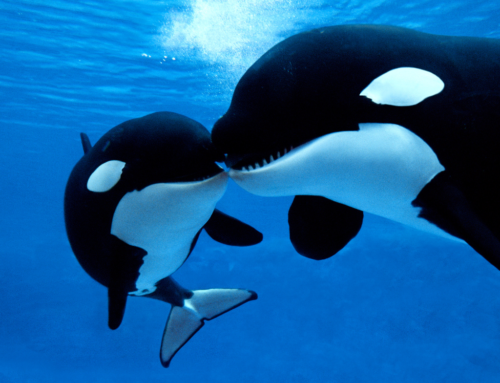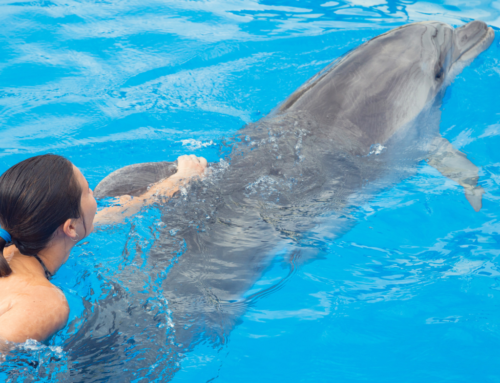
While traveling, it can be extremely difficult to determine what animal encounter experiences are ethical or not. Many hotels, hostels, and tourism boards advertise seemingly ethical encounters that experts agree are detrimental to the well-being of the animals involved. Here are some major Dos and Don’ts in the animal and wildlife tourism world!
Table of Contents
DON’T Ride Elephants
Many travelers know about this big travel don’t, but this includes ANY activities with trained elephants in South East Asia. Riding elephants and elephant performances have decreased in popularity, but elephant begging and photoshoots on the beach have become more popular. Each of these activities requires brutal training on the elephants and directly inhibits their natural behaviors.
DO Volunteer with Rescued Elephants

Volunteering with rescued elephants at the Elephant Nature Park
Instead, try to find an ethical elephant sanctuary! Sanctuaries that rescue elephants from tourism and do not allow tourists to ride, bathe, or frequently interact with them are the best. Many ethical sanctuaries still allow volunteers to feed the elephants, help upkeep their grounds, and make food for those with medical issues. Even better, just observe the rescued elephants and listen to their stories!
*Note: Many elephant parks will label themselves as a sanctuary or rescue. Do some more digging to see if they offer any of the less ethical interactions with their elephants.
DON’T Take Wildlife Selfies
Wildlife selfies can come in many forms. The most famous involves sedated large cats such as tigers, but can also involve elephants, chimps, and other wildlife. These photoshoots at the least inhibit natural behaviors and at the most involve cruel sedation, training, and abuse.
DO Find Ethical Safaris and Tours
Instead, find an ethical safari or tour through a rescue. The best safaris will drive or lead hikes through natural parks where the animals can live with minimal human interaction. Some rescues house injured, rescued, or displaced wildlife that may not be able to be released. Do some digging on these rescues to make sure they’re as ethical as possible and don’t allow direct animal interaction.
DON’T Visit Roadside Zoos
With the Netflix documentary Tiger King in 2020 came a behind-the-scenes look for many people at how roadside zoos function. These “zoos” do not need to follow any guidelines for the health and safety of their animals and often offer selfies and other experiences that are less than ethical. Many of these roadside zoos will use trigger words to lure guests in such as “conservation”, “education”, and “ethical”.
DO Visit AZA-Accredited Zoos

An AZA zoo is accredited by the Association of Zoos and Aquariums, which requires a high standard of care that is constantly being updated with research from animal behaviorists, veterinarians, and biologists. At the very least, check whether the zoo you plan on visiting is supported by this organization. If they aren’t, do some further digging.
DON’T Swim with Dolphins
Dolphins may appear friendly with their smiling faces but can be quite dangerous to people and dogs who decide to swim with them. Dolphins become highly stressed when boats chase them around water or when people jump into their swimming pods. This has resulted in the death and injuries of dogs, people, and dolphins, calves being separated from their mothers, and radical changes in natural behaviors. Any boat tour that advertises swimming or following dolphins is highly illegal in the United States and unethical in other countries.
DO Observe Dolphins and Whales from a Distance

The most ethical dolphin and whale tours involve, well, sitting for long periods of time on the open water. During peak migration times when these tours are often most popular, you are almost guaranteed to see a whale or dolphin simply due to the large number of them in the area. From my own experience, I couldn’t boat more than 10 minutes while living in Florida without seeing a dolphin or two, and often saw them just walking along the water.
DON’T “Snuggle” Wild Animals
Photos of tourists snuggling sloths, koalas, and other cute and cuddly animals flood Instagram feeds every year. However, this direct interaction with these wild animals is often extremely stressful for them and can directly cause injury, illness, and a change in behavior. In many of these destinations, wild animals are captured and put in parks labeled as “sanctuaries” for tourists to hold, when in reality they didn’t need rescuing at all!
DO Observe From a Distance or Volunteer
Instead, join a hiking tour or safari to observe wildlife in their native habitat or volunteer at a more ethical rescue. Ethical rescues will not allow direct holding or contact with the wildlife unless you are there to provide veterinary or other specialized care. Wouldn’t you rather have a beautiful photo of a koala in their native habitat instead of holding them and causing damage?
This list is far from complete, but I included many of the most popular animal interactions travelers are confronted with worldwide.
Like this article? Pin it!
















Leave a Reply